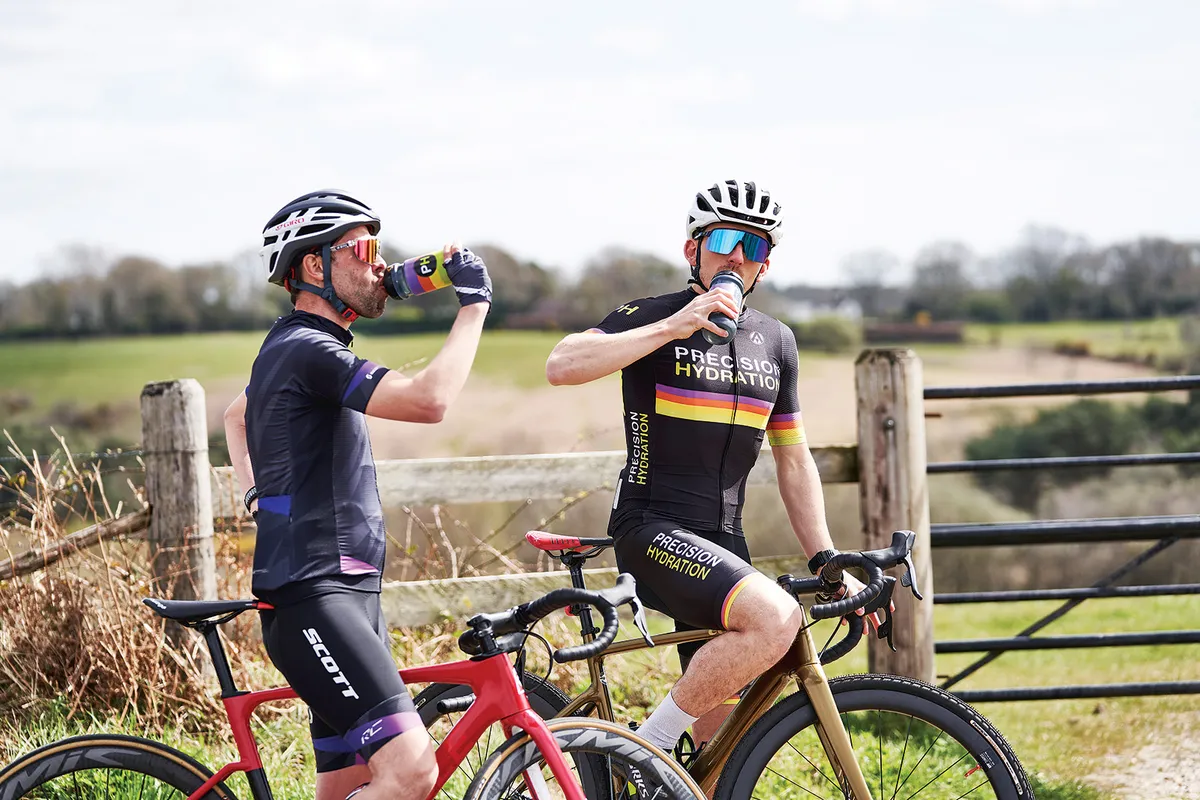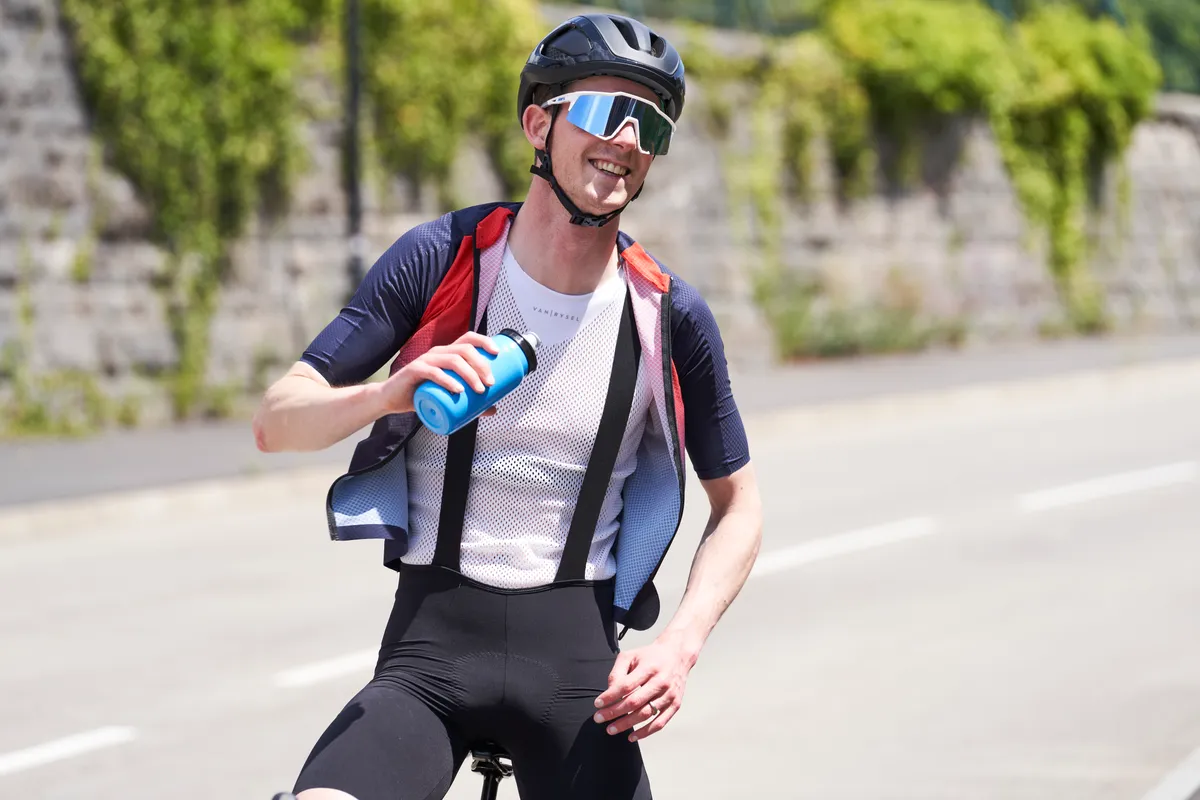Staying well hydrated on a bike ride is crucial in hot and cool temperatures alike.
Scientists broadly agree that minor dehydration impairs cycling performance and that more severe dehydration can cause serious issues, like heatstroke.
On the other hand, being too hydrated is also dangerous.
This balance can be hard to strike. We’ve spoken to Dr Nidia Rodriguez-Sanchez, who has a PhD in hydration physiology, two WorldTour cycling nutritionists and Andy Blow from Precision Fuel and Hydration to help explain how much and what you should drink on the bike.
Why is hydration important?

A typical man is about 60 per cent water. The average woman is roughly 55 per cent water because muscle holds more water than fat, which women usually have more of.
This also means that endurance athletes, such as cyclists, will tend to store more water than a less lean person.
Water is crucial for homeostasis – the way in which the body regulates itself to work properly.
Normal bodily functions such as waste removal and temperature regulation are impossible without water.

Dr Rodriguez-Sanchez, a lecturer in physiology and nutrition at the University of Stirling, likens the levels of water in our body to a “bank balance”.
“We are always losing water through breathing and sweat and replacing it with drink and food,” she says.
Failure to compensate for water loss leads to dehydration, defined as a decrease in the body’s normal levels of water.
It causes “changes in cardiovascular, thermoregulatory, metabolic, and central nervous function that become increasingly greater as dehydration worsens”, according to a 2007 article by Bob Murray in the Journal of the American College of Nutrition.
The effects of dehydration on cyclists

Being only slightly dehydrated on a bike ride is detrimental, says Dr Rodriguez-Sanchez.
“It’s important we don't lose more than two per cent of our body mass otherwise performance will be impaired,” she explains.
Dehydration is usually measured as a percentage of body weight lost from water.
So, a 70kg cyclist would want to avoid losing more than 2kg of body mass on a ride – two per cent of 70kg is 1.4kg, but some of the weight loss will be glycogen (stored carbohydrates).
Lower VO2 max, exhaustion and cramping

The negative impact on performance relates to an effective reduction in VO2 max, an increase in our rate of perceived exertion and possible increased risk of cramps.
“Someone who is four per cent dehydrated won’t be reaching their VO2 max – they might only be at 75 per cent of it,” she says.
“They are more likely to feel exhausted and there is some association with higher cramp incidents.”
Dr Rodriguez-Sanchez says losing more than two per cent can also put the cyclist’s health at risk.
“From that loss of water, there’ll be dizziness and if it’s greater than four or five per cent, there is a higher risk of heat stroke,” she adds.
Will Girling, nutritionist at the EF Education-EasyPost WorldTour team, says there are several signs of dehydration.
“You may start to feel weak, nauseated, bloated or confused,” he explains.
“Developing muscle cramps, headache, slurred speech or swollen hands and feet during or after prolonged exercise can be symptoms of dehydration and hyponatremia, a severe loss of electrolytes.”
How much should you drink?

Sports scientist Andy Blow, who is CEO of Precision Fuel and Hydration, suggests drinking one 500ml water bottle an hour in mild weather and two per hour when cycling in hot weather.
But everyone’s sweat rate is different, so these generic guidelines aren’t very useful.
A better way to figure out how much to drink on a bike ride is to calculate how much fluid you lose.
Bear in mind it’s not necessary or desirable to replace all the water lost on the ride itself – just try not to lose more than two per cent body mass.
Overdrinking can cause exercise-associated hyponatremia (EAH). In this condition, sodium is diluted by water to dangerously low levels in the blood, potentially causing kidney failure and death.
In a less serious scenario, Dr Rodriguez-Sanchez says: “It will impact our gastric emptying, which can make us feel uncomfortable during exercise.”
Scientists have observed EAH in marathon runners who started a race overhydrated (some reported drinking 8-10 litres of water the day before) and drank a lot during it.

On the other hand, you don’t want to set out dehydrated.
“Sometimes it has been observed that mostly male athletes start their training sessions or their competition already dehydrated,” says Dr Rodriguez-Sanchez.
Since men tend to sweat more than women, pre-exercise hydration is particularly salient for male cyclists.
Although not fail-safe, studies have found that urine colour is a decent proxy for hydration status.
On Armstrong’s urine colour chart (not that Armstrong), lighter is better than darker.
Take your own sweat test
Instead of paying for a lab test, taking a DIY sweat test is free and still effective.
Girling recommends the following protocol:
- Weigh yourself without clothes before the ride
- Carry a known amount of water and ensure you drink all of it during the ride
- Add any food or gel weight
- If you had a pee, add the estimated weight you lost
- After the ride, strip, dry yourself and weigh in
By comparing the results of the two weigh-ins, you can calculate your sweat rate during the ride.
For example, if you weighed 65kg before a two-hour ride and 63.5kg after but drank a litre (1kg) water during the ride, then you lost 2.5kg of water, or 1.25kg per hour.
This is higher than two per cent, so you’ll know you should’ve drunk more. If you come back heavier, you’ve certainly drunk too much.

Dr Rodriguez-Sanchez recommends testing your sweat-loss rate at different temperatures and intensities.
During harder intervals, your heart rate will be higher than on endurance rides, so you’ll breathe out more water. Your muscles will also produce more heat, requiring more sweat to cool you down.
“In winter, we're still losing fluid but we are not perceiving it as much as during the summer,” says Dr Rodriguez-Sanchez.
“We're losing water through our breathing. We are wearing a couple of layers and this technology in the fabric might have an impact on our sweat rate.”
Drink to thirst

Another way to stay hydrated on a bike ride is to drink to thirst.
Academics in favour of this approach cite evidence, including from a 2010 study by researchers from the University of KwaZulu Natal, that drinking as much as desired stops cyclists losing more than two per cent of their body weight in water.
“For 99 per cent of people, it’s fine to drink to thirst,” says Dr Tim Podlogar, an exercise physiologist from the University of Birmingham.
He is also a nutritionist at Bora-Hansgrohe WorldTour team. He doesn’t recommend that riders match fluid intake with sweat rates and try to drink a set amount.
Dr Podlogar adds that drinking to thirst prevents you from gaining weight during exercise from excessive fluid intake.
“If you're sensible and you drink to thirst I think this just can't happen because you will always end up your training session or your bike race lighter than you started it,” he says.
“And I think the biggest problem is drinking more than what you sweat out, which is pretty hard to achieve.”
However, Dr Rodriguez-Sanchez believes waiting until you’re thirsty to drink leaves it too late.
“When we start feeling thirst, we are already dehydrated, so normally thirst will be triggered when we have already lost two per cent of our body mass through sweating,” she says.
Key cycling hydration tips
Our experts’ advice on drinking on a bike ride can be boiled down to the following points:
- Start hydrated
- Work out your sweat rate to establish a hydration target, or drink to thirst
- Consider electrolytes for long rides and if you’re a salty sweater
- Don’t forget carbohydrates
- Don’t overdrink
- Rehydrate post-ride with water and sodium, which can be from food
How much weight is safe to lose during exercise?
Dr Rodriguez-Sanchez says elite runners and cyclists will sometimes lose a significant amount of weight during a race while maintaining performance.
For example, a 2012 study published in the Clinical Journal of Sports Medicine found that Haile Gebrselassie lost 9.8 per cent of his body weight in the 2008 Dubai Marathon. He won in 2:05:29.
“They might be performing well but that [weight loss] is putting them at higher risk [of heat complications],” says Dr Rodriguez-Sanchez.
That said, it is likely that a lot of Gebrselassie’s weight loss came from glycogen stores he used while running at such a high speed.
What should you drink on a bike ride?

Blow recommends drinking a combination of sports drinks and plain water to replace the carbohydrates, salts and fluids you lose during exercise.
He says: “In the Tour de France they’ll drink a lot of energy drinks, as well as a lot of water and electrolytes separately.”
While cycling in hot weather, Blow says you should drink more plain water and electrolytes because high-carb energy drinks can cause GI distress in the heat.
In winter, you’ll sweat less, so you will need to drink less. This means one bottle of higher-carb energy drink and another with plain water or a low-strength electrolyte mix are good options.
Blow says Lotto-Dstny riders use Precision Fuel and Hydration’s Carb Only Drink Mix during the Spring Classics. This stops the riders over-consuming sodium and gaining weight through water retention.
But Dr Podlogar says electrolytes are still useful in winter. They stimulate thirst, which the cold weather can dull, and can stop you from peeing so often on a ride.
